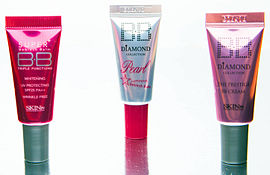To some, it could still seem slightly baffling as to what a BB cream even is exactly: just about every brand going has jumped on the bandwagon, and all of this new information could seem a little overwhelming. It's important to note that there is a clear difference between a tinted moisturiser and a BB cream: tinted moisturisers obviously moisturise (and with that comes anti-ageing qualities), but also offer coverage equivalent to a light foundation. They often contain sunscreen as well. BB creams are supposed to do all of this and more, and to my mind any extra qualities should be quantifiable - not just something vague like added radiance. BB actually stands for "blemish balm", so the first thing on the list should be an ingredient that actively combats blemishes (whether this is tea tree, salicylic acid, or another spot-fighting agent). They can also act as a makeup primer, meaning that this is another step that BB cream users can skip. In Asia, where the creams are extremely popular, they frequently contain a whitening agent, which understandably doesn't go down too well in Europe. In the West, BB is often said to stand for the far more woolly "beauty balm", which means that many products given this label are little more than tinted moisturisers with a different name. To me, that is a real shame, as there is little worse to me in the world of consumerism than shoppers being out-and-out conned.
However, this bombardment of information is set to become even more bewildering in 2013 thanks to the inception of CC and, yes, even DD creams. So what are the differences between DD creams, CC creams, BB creams, and tinted moisturisers?
CC can stand for "complete correction", implying that these would be good for those wishing to blur pigmentation and scars. However, CC is also reported to stand for colour correction, complexion control, and various combinations of these words, making them far less distinct from our friends the BB creams. They are essentially supposed to be revamped versions of BB creams - doing all that they do, but with more radiance, more and longer-lasting coverage, and with a lighter texture. In addition, they are meant to have an even lighter texture, and come in different tones for different needs, in the manner that we are already used to with concealers and primers (pink, yellow, blue, green and lavender, to correct redness, dullness, and so on).
The DD creams are meant to provide us with our daily defense. These, though, are not for the face, but for the feet and body. Given the battering my feet seem to get each day even when wearing flat shoes, this is a revolution that I am looking forward to. As well as softening the toughest skin like regular body creams, the more heavy-duty DD creams also promise to reduce other body blemishes, such as stretch marks.
Amazingly, AA creams also already exist (although they are far less common). These can theoretically be used by people with any skin type, and typically contain avocado, alpha lipoic acid, allantoin, and vitamin A to help with anti-ageing and general skin condition. Further to this, there are even whispers on the wind of EE (early elimination) creams - although it seems that very little is known about these at present.
You could ask why all of these categories are even significant. For genuinely new types of cream, it should be easy to distinguish these from others and not become confused. For other creams that are easy to mix up with others, surely it shouldn't matter what they are called or marketed as if they are right for your skin?
However, to my mind, it does matter - firstly from the point of view of cost. Clinique's BB cream is £25, while its tinted moisturiser is only £21.50. This also works for more affordable brands: Nivea's tinted moisturiser costs around £3.50, but its BB cream is closer to £6. If the BB cream genuinely offers different benefits, then a higher price can perhaps be justified - but if there is no difference at all (as is often the case in the West, whose brands frequently put notoriously little effort into their BB creams), then why should the consumer pay more for what is essentially just the bandwagon of a new trend, even if the difference is in name only?
Then there is the basic matter of integrity and transparency, and respect for the customer. If you treat your customers like idiots, and they find out, they will vote with their feet.
So my advice is this: don't touch a BB, CC, or DD cream with a bargepole unless you know full well what you're buying, and can justify the cost, knowing that the product is genuinely different to existing concepts. I therefore offer this handy "cut-out-and-keep" guide, just the right size to keep in your purse, so that you know what you're getting:
|
Type of cream
|
This cream should :
|
|
BB
|
Moisturise, anti-age, have an SPF, offer light coverage or better,
combat blemishes
|
|
CC
|
Moisturise, anti-age, have an SPF, offer medium coverage or better, combat
blemishes and scars, come in different tones for different needs
|
|
DD
|
Be for the feet and body, intensively moisturise, reduce body
blemishes
|
And as jokes abound regarding the similarity of these cream names compared to the nation's bra sizes, it's my hope that retailers and manufacturers will wise up and begin to inform consumers better about their choices. That, after all, is why I started blogging - and rest assured that as soon as more information about EE creams (and who knows? FF creams, GG creams...) becomes available, I will be right here waiting for you.















No comments:
Post a Comment